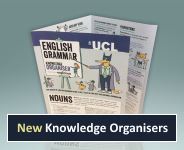Ambiguity and headlines
Newspaper headlines often compress sequences of actions into very compact structures. Sometimes the meaning becomes ambiguous as a result.
Goals
- Study examples of real ambiguity in language from newspapers.
- Show comprehension by paraphrasing each possible meaning for each example.
- Apply semantic analytical skills by identifying which words might be interpreted in more than one way.
- Apply grammatical analytical skills by grouping words together in relation to each possible meaning.
Lesson Plan
The teacher explains that today we will discuss ambiguity. Ambiguity occurs when a word, phrase, or sentence can be interpreted with multiple, different meanings. In the examples here, the different meanings may relate to the different meanings of a particular word, or to the way that phrases are grouped in a sentence.
The Activity page appears in the menu entitled 'This Unit' in the upper right corner of this page. Each slide in the Activity page presents an example of an ambiguous headline drawn from a real newspaper. The students' task is to identify the multiple possible meanings, select the most likely intended meaning, and then describe those meanings grammatically. Their instructions are as follows (and we walk through the first example below):
- Paraphrase the example with each possible meaning or interpretation. Try writing a complete sentence that states each possible meaning more clearly.
- Select the interpretation that is most likely to be the intended meaning.
- Ask whether there are particular words that could be interpreted in multiple ways. Often, one word could be a noun or a verb, and this is part of the ambiguity.
- Group the words together as units related to each interpretation.
Here is the first example:
- Police chase driver in hospital.
There are two clear interpretations to this:
- The police chased a driver into a hospital, or chased them while they were inside a hospital.
- A driver who has been involved in a police chase has ended up in hospital.
The second interpretation is most likely to be the intended meaning.
What words could be interpreted in multiple ways? The key here is the word chase. Chase can be a noun or a verb. In the intended meaning, chase is a noun which modifies the noun driver and is modified by the noun police, all within the larger noun phrase police chase driver. In the alternative interpretation, chase is a verb.
Here is how the words might be grouped in the intended interpretation. Students should feel free to just group the words as below, or to add the labels for the kinds of phrases that each word or group of words represents.
| Police chase driver | in hospital | |
| Noun Phrase | Preposition Phrase |
And here is how the words might be grouped in the alternative interpretation:
| Police | chase | driver | in hospital | |||
| Noun Phrase | Verb Phrase | Noun Phrase | Preposition Phrase |
For more information onambiguity in headlines, see this article in the New York Times.
Welcome!

Englicious is totally free for everyone to use!
But in exchange, we ask that you register for an account on our site.
If you’ve already registered, you can log in straight away.
Since this is your first visit today, you can see this page by clicking the button below.
- Printer-friendly version
- Log in to view or leave comments

